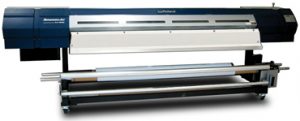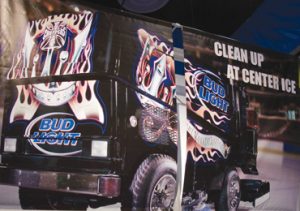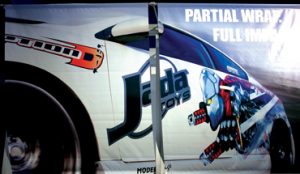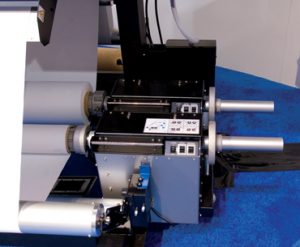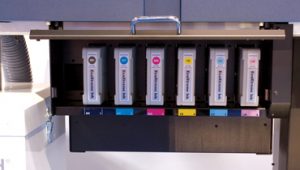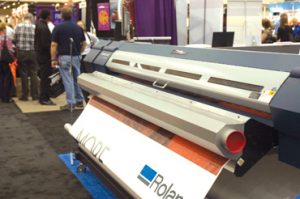Digital Printing
Roland Goes Pro with AdvancedJet AJ-1000
A grand-format printer for all-size shops
Published
18 years agoon
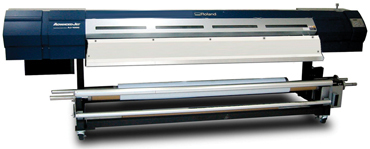
Clearly an odd convergence permeates the digital-printing world. Only a few years ago, for example, the widest-format printer you'd see in a small-to-medium-size signshop would range between 60 and 72 in. — not quite wide enough to qualify as true grand format. For larger work, the grand-format guys had everything to themselves.
Approximately two years ago, manufacturers of traditional, wide-format printers penetrated the grand-format field by offering printers that could handle 100-in. or larger media, at prices that wouldn't break the bank. To some extent, the field was being leveled; however, these new "baby grands" weren't built for a production shop's demands, but for the occasional ultra-wide print. Basically, they were scaled-up versions of existing printers.
Roland DGA Corporation helped pioneer compact, grand-format printers. Obviously, the company recognized the market for a durable, production-type, grand-format printer. It also saw the benefits of printing with environmentally friendly solvent inks rather than standard solvent types. Its research said many shops would like to produce wide output as a primary product, but couldn't afford a $250,000 purchase price.
Its engineers went to work, and, at the ISA's Sign Expo 2006, Roland offered its industrial-strength AdvancedJet AJ-1000, a 100-in.-wide printer built to produce grand-format prints with reduced operator intervention.
Oh yes, it offers such performance for $69,995. So, if this interesting, stick with us and we'll tell you more.
AdvertisementSpecifications
When we first saw the AJ-1000, we weren't sure it was Roland's printer. It's a big beast, and the cowling's color was now a dark, charcoal color, instead of Roland's normal gray. Looking more closely at the specification sheet, we learned the AJ-1000 is a very different animal.
So, just how big is it? If you think the 169 3⁄8-in.-wide x 43 7⁄8-in.-deep x 55 11⁄16-in.-high printer is one that you and a couple of buddies can install, think again. The printer and stand weigh a hefty 1,319 lbs. This isn't just another stretched inkjet; it's the real deal.
Solvent-based printers require a media heating/drying unit. On the AJ-1000, heating occurs in three stages — prior to, during and after printing. You'll need two, 200- to 240VAC, 50/60Hz power sources, one for the printer and one for the heater/dryer. Each unit draws 10 amps. The operating-temperature range is 68 to 90° F; humidity should range between 35 and 85%, non-condensing.
Given these requirements, let's examine the printer. The wide-gamut, inkjet printer lays down six colors: cyan, magenta, yellow, black, light cyan and light magenta.
The printer's maximum resolution is 720 dpi, so you can produce photo-quality work. The upgraded, piezo-technology printheads are its prime feature — they're production grade, heavy duty and made from stainless steel.
AdvertisementThe AJ-1000 accepts media widths up to 104 in.; the maximum print width is 102.33 in.; the minimum is 48 in.; media thickness should not exceed 0.39 in. The printer is designed to handle large and heavy media rolls that should have a 3-in. core, and the media-handling system (Fig. 1) handles roll weights up to 220 lbs.
It uses a 10/100 Ethernet interface connection.
Speed and endurance
It's a serious printer, so let's discuss anticipated production. You can produce photo-quality images at 720 x 720 dpi, the high-quality (Fig. 2) mode. This selection runs the printer at its slowest speed, but you can still expect to produce 124 sq. ft./hr. That figure roughly equates to 10, 3 x 4-ft. prints per hour. If you are working on large prints or banners for viewing in a relatively close space — like a store or exhibit hall — choose the standard mode and up your speed to 484 sq. ft./hr. It's not a Porsche 911, but you can produce 40, 3 x 4-ft. prints in one hour.
AdvertisementWant to produce large, billboard-quality output to be viewed from a distance? The AJ-1000 features a billboard mode that prints 360 x 180 dpi. Stand back. The speed shoots up to 968 sq. ft./hr. Using our 3 x 4-ft. print comparison, you can now produce 80 prints an hour. Even better, you can produce a variety of work — posters to banners to billboards — on the same printer.
Print speed has little value if you must constantly stop and refill ink, wait for images to dry or perform maintenance. As stated, the AJ-1000 is designed for production environments, and Roland didn't overlook these aspects.
All experienced operators know the annoyance of changing ink in the middle of a run. The AJ-1000 uses one-liter cartridges (Fig. 3) to insure you can print for a long time. In addition, the machine's reservoir system allows you to change ink on the fly. This feature separates industrial from occasional printing. Also, chip-equipped ink cartridges track ink levels, so there's no guessing on reserves.
The AJ-1000's full-media, take-up system (Fig. 4) is accessible from the machine's front side. Use this in combination with the heater/drying system to run the printer at its highest speed in the unattended mode.
Solvent-ink printheads must be kept clean. On some systems, the daily cleaning requirement can be both messy and time consuming. The AJ-1000 is designed to minimize maintenance. Its automatic system cleans the printheads on an 18- to 24-hour basis. In addition, the printer's solution-soaked wipers clean the printheads and eliminate gunk buildup. The solution comes in a 500ml cartridge that Roland says will last one year. Certain operator maintenance is required, but only every two weeks, as opposed to daily.
Eco-Xtreme ink
With a new generation of printers, new ink is needed. The AJ-1000 uses Roland's advanced, Eco-Xtreme, eco-friendly, solvent ink that's formulated for industrial, high-speed applications. These inks deliver excellent color density, a wide gamut and better durability than Roland's standard eco-solvent inks.
The company says these inks are more resistant to water, alcohols and fading caused by UV light. They also bond better with the media and are much more scratch resistant. Remember, the AJ-1000 solvent printer can print on a wide range of uncoated media.
We were very impressed with the images we saw at the show. The colors were vivid and dense.
Roland's product managers caution that Eco-Xtreme ink emits some odor, even though it's an environmentally friendly solvent. Therefore, they say, you'll want a ventilation system in the print room. The company may offer an optional, air-filtration system (Fig. 5).
VersaWorks RIP
You may think you have to buy a RIP to drive the beast. Not so. Roland includes its VersaWorks RIP. It works with either Windows 2000 or Windows XP. Roland developed this software for its high-end printers. It's a true Adobe PostScript RIP, so don't expect surprises while processing images. It also includes many advanced features not found in the lesser RIPs normally included with wide-format printers.
Because you'll be printing large images, you'll need a fairly good PC to run VersaWorks. You can operate with a 2GHz processor in place, but know that 3GHz is recommended. You'll also want 512MB (1GB recommended) of RAM and at least 4GB of free disk space. The PC should also have an Ethernet adapter.
VersaWorks allows image nesting to conserve media. Tiling is included in the software as well; even at 102 in. of printable width, you may have to handle some jobs as tiles. The RIP can also act as a print server, which allows you to attach several design workstations. This capability requires no additional license fee. You'll also find numerous color-management features that help ensure color accuracy. All in all, it's a solid RIP that will get you going almost immediately.
Conclusion
In designing, building and presenting the AJ-1000, we believe Roland has acknowledged that many shops are interested in producing wider prints, faster. If you need continuous operation and want to seriously enter the larger-poster and billboard market, the AJ-1000 will allow you to compete without breaking your bank.
But remember that Roland's 104-in.-wide SOLJET SJ-1045 is available for lighter-duty, grand-format printing. Although it's an excellent printer, the SJ-1045 isn't designed for the speed and continuous operation you'll find with the AJ-1000. Depending upon your workload, you have a choice.
Key Information
Roland DGA Corporation
15363 Barranca Parkway
Irvine, CA 92618-2216
(800) 542-2307
(949) 727-2112
Contact: Joe Dawson, industrial products group manager
jdawson@rolanddga.com
Company Profile:
Roland DGA Corporation is the U.S.-based marketing, distribution and sales arm of Roland DG Corporation of Hamamatsu, Japan, a worldwide manufacturer in the sign, graphic-arts, fine-art, photography, engraving and 3-D-modeling industries founded in 1981
System Requirements:
Pentium 4 processor at 2GHz or faster; 512MB of RAM, 1G preferred; 40GB hard drive; Ethernet interface; Windows 2000 or XP Professional
SPONSORED VIDEO
Introducing the Sign Industry Podcast
The Sign Industry Podcast is a platform for every sign person out there — from the old-timers who bent neon and hand-lettered boats to those venturing into new technologies — we want to get their stories out for everyone to hear. Come join us and listen to stories, learn tricks or techniques, and get insights of what’s to come. We are the world’s second oldest profession. The folks who started the world’s oldest profession needed a sign.
You may like
Advertisement
Subscribe

Magazine
Get the most important news
and business ideas from Signsofthetimes Magazine.
Advertisement
Most Popular
-

 Tip Sheet1 week ago
Tip Sheet1 week agoAlways Brand Yourself and Wear Fewer Hats — Two of April’s Sign Tips
-

 Photo Gallery3 days ago
Photo Gallery3 days ago30 Snapshots of the 2024 ISA Sign Expo
-

 Ask Signs of the Times5 days ago
Ask Signs of the Times5 days agoWhy Are Signs from Canva so Overloaded and Similar?
-

 Real Deal2 weeks ago
Real Deal2 weeks agoA Woman Sign Company Owner Confronts a Sexist Wholesaler
-

 Benchmarks1 week ago
Benchmarks1 week ago6 Sports Venue Signs Deserving a Standing Ovation
-

 Photo Gallery6 hours ago
Photo Gallery6 hours ago21 Larry Albright Plasma Globes, Crackle Tubes and More
-

 Women in Signs2 weeks ago
Women in Signs2 weeks ago2024 Women in Signs: Megan Bradley
-

 Women in Signs1 week ago
Women in Signs1 week ago2024 Women in Signs: Ashley Borell

